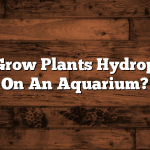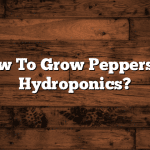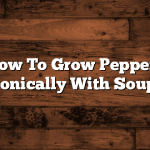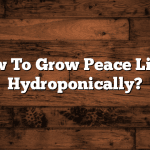Understanding the Importance of Epsom Salts in Hydroponic Systems
Epsom salts, also known as magnesium sulfate, play a crucial role in hydroponic systems. Magnesium and sulfur, the two essential components of Epsom salts, are essential nutrients that aid in the growth and development of plants. The addition of Epsom salts to the hydroponic solution ensures that plants have an adequate supply of these nutrients, promoting healthier and more vigorous growth.
Magnesium, one of the key elements in chlorophyll, is essential for photosynthesis and energy production within plants. It is also involved in the activation of enzymes that are responsible for numerous metabolic processes. Sulfur, on the other hand, is essential for the production of proteins, enzymes, and vitamins. It also plays a crucial role in the formation of chlorophyll, which is essential for the plants’ utilization of light energy. In hydroponic systems, where plants rely solely on nutrient solutions for their growth, the addition of Epsom salts ensures that magnesium and sulfur are readily available to the plants, promoting optimal growth and overall plant health.
When it comes to hydroponics, understanding the importance of Epsom salts is vital in providing plants with the necessary nutrients for their growth. The lack of magnesium and sulfur can lead to various deficiencies and stunted plant growth. Therefore, it is essential to determine the right concentration of Epsom salts in the hydroponic solution to ensure that plants receive the appropriate amount of these nutrients. Additionally, factors such as plant species, environmental conditions, and nutrient uptake rates should be considered to accurately assess the Epsom salt requirements in hydroponics. By carefully monitoring and adjusting the Epsom salt concentration, hydroponic growers can ensure optimal plant growth and prevent any nutrient deficiencies that could hinder the health and productivity of their plants.
The Role of Magnesium and Sulfur in Plant Growth
Magnesium and sulfur are two essential nutrients for plant growth and development. Magnesium plays a vital role in chlorophyll synthesis, which is crucial for photosynthesis, the process by which plants convert sunlight into energy. It also aids in the activation of enzymes involved in carbohydrate metabolism, protein synthesis, and cell division. Without sufficient magnesium, plants may exhibit stunted growth, yellowing of leaves (chlorosis), and reduced yields.
Sulfur, on the other hand, is a component of various amino acids, vitamins, and enzymes necessary for plant metabolism. It is involved in the synthesis of proteins and essential plant compounds, such as hormones and secondary metabolites. Sufficient sulfur levels in plants promote vigorous growth, enhance root development, and increase overall plant resistance against diseases and pests. A deficiency in sulfur may lead to yellowing or bronzing of leaves and reduced plant vigor.
In conclusion, both magnesium and sulfur play critical roles in plant growth and development. Understanding their importance and ensuring their adequate supply is vital for maintaining healthy and thriving hydroponic systems. By providing these essential nutrients in the correct concentrations, hydroponic growers can optimize plant growth, improve nutrient uptake efficiency, and maximize crop yields.
Determining the Right Epsom Salt Concentration for Hydroponic Solutions
Epsom salt, also known as magnesium sulfate, plays a crucial role in hydroponic systems by providing the essential nutrients magnesium and sulfur to plants. Determining the right concentration of Epsom salt in hydroponic solutions is vital to ensure optimal plant growth and development.
To determine the appropriate Epsom salt concentration, it is important to consider various factors such as the specific needs of the plant species, growth stage, and environmental conditions. Different plants may require different levels of magnesium and sulfur, so it is essential to conduct thorough research or consult experts to determine the ideal concentration.
One way to determine the right Epsom salt concentration is through regular monitoring of plant performance and nutrient levels. By regularly testing the nutrient solution, including magnesium and sulfur levels, growers can identify any deficiencies or imbalances and adjust the Epsom salt concentration accordingly. This allows for precise control over the plant’s nutrient intake, ensuring that it receives the optimal amount of magnesium and sulfur for healthy growth.
Additionally, it is important to consider the solubility of Epsom salt in hydroponic solutions. Inadequate dissolution of the salt can lead to uneven nutrient distribution and potentially harm the plants. Therefore, precise measurements and careful dissolution of Epsom salt are necessary to ensure uniform nutrient availability in the hydroponic system.
Determining the right Epsom salt concentration is a critical factor in hydroponic systems. By understanding the needs of the plants and regularly monitoring nutrient levels, growers can provide the optimal amount of magnesium and sulfur for healthy and productive growth.
Factors Affecting the Epsom Salt Requirements in Hydroponics
There are several factors that can influence the Epsom salt requirements in hydroponic systems. One such factor is the type of plants being grown. Different plants have varying levels of magnesium and sulfur requirements, so the optimal concentration of Epsom salts will depend on the specific plant species.
Another factor to consider is the stage of growth of the plants. As they go through different growth stages, such as vegetative growth and flowering, their nutrient requirements can change. It is important to periodically assess the nutrient levels in the hydroponic solution and adjust the Epsom salt concentration accordingly to ensure optimal plant health and growth.
Additionally, environmental factors play a role in determining the Epsom salt requirements. Factors such as temperature, humidity, and light intensity can affect a plant’s nutrient uptake and utilization. It is important to monitor and control these factors to ensure that the plants are receiving the appropriate amount of magnesium and sulfur from the Epsom salts.
Overall, understanding and considering these factors is crucial in determining and maintaining the right Epsom salt concentration in hydroponic systems. By carefully adjusting the concentration based on the specific plant species, growth stage, and environmental conditions, growers can ensure that their plants receive the necessary nutrients for healthy and productive growth.
Identifying Signs of Magnesium and Sulfur Deficiency in Hydroponic Plants
Magnesium and sulfur are vital elements in plant growth, and their deficiency can have detrimental effects on hydroponic plants. Identifying signs of deficiency is crucial for maintaining the health and productivity of your hydroponic system.
One common symptom of magnesium deficiency is chlorosis, which is the yellowing of leaves. In the case of magnesium deficiency, the yellowing starts at the leaf margins and slowly progresses towards the center, giving the leaves a marbled appearance. Additionally, the affected leaves may develop necrotic spots, and their growth may be stunted. Sulfur deficiency, on the other hand, often presents as a general overall yellowing of the entire plant. The yellowing tends to start from the newest growth and gradually spread to older leaves. The leaves may become thin and brittle, and the plant’s overall vigor and growth rate may decline.






